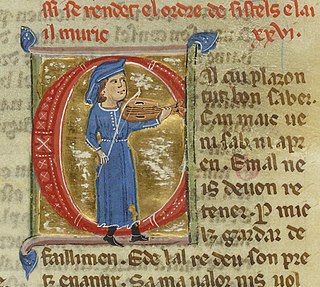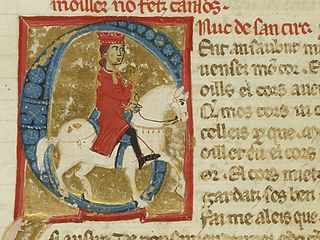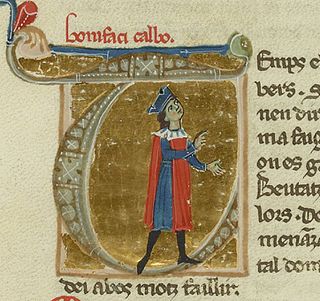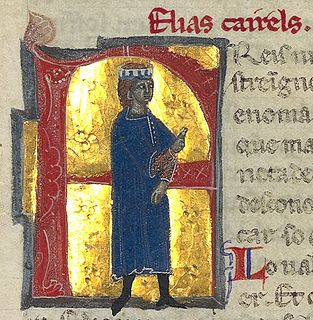Notes
- ↑ Aubrey, Elizabeth. The Music of the Troubadours (Indiana University Press, 1996), p. 16. ISBN 0-253-21389-4.
- ↑ The Vidas of the Troubadours, ed. and trans. Margarita Egan (New York: Garland, 1984), p. 44. ISBN 0-8240-9437-9.
Elias or Elyas d'Ussel or d'Uisel (fl. c. 1200) was a Limousin troubadour, the cousin of the three brothers Eble, Peire, and Gui, and co-castellan with them of the castle of Ussel-sur-Sarzonne, northeast of Ventadorn. [1]
According to Gui's vida , Elias composed "good tensos . [2] He has left behind four tensos, one partimen , and two coblas . He composed one series of verses with Gaucelm Faidit. The complete works of the four relations of Ussel, including Eble, were first compiled in one volume by J. Audiau as Les poésies des quatre troubadours d'Ussel (Paris, Delagrave, 1922). They are all available online at trobar.org.

A troubadour was a composer and performer of Old Occitan lyric poetry during the High Middle Ages (1100–1350). Since the word troubadour is etymologically masculine, a female troubadour is usually called a trobairitz.

Azalais de Porcairagues or Alasais de Porcaragues was a trobairitz, composing in Occitan in the late 12th century.
Eble II of Ventadorn was viscount of Ventadour. He was born at some date after 1086, the son of Eble I and of Almodis de Montberon.
Maria de Ventadorn was a patron of troubadour poetry at the end of the 12th century.

Peire d'Alvernhe or d'Alvernha was an Auvergnat troubadour with twenty-one or twenty-four surviving works. He composed in an "esoteric" and "formally complex" style known as the trobar clus. He stands out as the earliest troubadour mentioned by name in Dante's Divine Comedy.

Uc de Saint Circ or Hugues (Hugh) de Saint Circq was a troubadour from Quercy. Uc is perhaps most significant to modern historians as the probable author of several vidas and razos of other troubadours, though only one of Bernart de Ventadorn exists under his name. Forty-four of his songs, including fifteen cansos and only three canso melodies, have survived, along with a didactic manual entitled Ensenhamen d'onor. According to William E. Burgwinkle, as "poet, biographer, literary historian, and mythographer, Uc must be accorded his rightful place as the 'inventor' (trobador) of 'troubadour poetry' and the idealogical trappings with which it came to be associated."

Bonifaci, Bonifatz, or Bonifacio Calvo was a Genoese troubadour of the late thirteenth century. The only biographical account of his life is found in the vida of Bertolome Zorzi. He is, however, the most notable Genoese troubadour after Lanfranc Cigala. In total, nineteen of his poems and two descorts have survived.

Gui d'Ussel, d'Ussèl, or d'Uisel was a turn-of-the-thirteenth-century troubadour of the Limousin. Twenty of his poems survive: eight cansos, two pastorelas, two coblas, and eight tensos, several with his relatives and including a partimen with Maria de Ventadorn. Four of his cansos melodies remain.
Eble or Ebles d'Ussel was a Limousin troubadour, the eldest of three brothers, castellans of the castle of Ussel-sur-Sarzonne, northeast of Ventadorn. His younger brothers were Peire and Gui and he also had a cousin named Elias, all troubadours. Of his corpus only one tenso, one partimen, and a cobla survive. The only sources for his life, besides his own songs, are the vida of his brother Gui and a document recording the donation of land to the abbey of Bonaigue by two brothers Guido and Eblo Usseli. According to Gui's vida, Eble composed "bad tensos".
Peire d'Ussel or d'Uisel was a Limousin troubadour, the middle of three brothers, castellans of the castle of Ussel-sur-Sarzonne, northeast of Ventadorn. His elder brother was Eble and his younger Gui, and he also had a cousin named Elias; all four were troubadours.

Daude, Deude, Daurde, or Daudé de Pradas was a troubadour from Prades-Salars in the Rouergue not far from Rodez. He lived to an old age and left behind seventeen to nineteen cansos, including twelve on courtly love, three about sexual conquest, one tenso, one planh, and a religious song. Only one melody of his entire oeuvre has survived.

Elias Cairel was a troubadour of international fame. Born in Sarlat in the Périgord, he first travelled with the Fourth Crusade and settled down in the Kingdom of Thessalonica at the court of Boniface of Montferrat (1204–1208/10) before moving back to western Europe, where he sojourned at the court of Alfonso IX of León (1210–11) and in Lombardy (1219–1222/24). He wrote fourteen surviving lyrics: ten cansos, one tenso, one descort, one sirventes, and one Crusade song. He was partial to refrain rhyming and coblas capfinidas.

Uc de la Bacalaria was a Limousin troubadour from La Bachellerie near Uzerche, the home town of Gaucelm Faidit. According to his vida, he was a jongleur who travelled infrequently and was hardly known. He composed cansos, tensos, one alba, and one descort. Six songs are surviving: one canso, one alba, and four tensos. According to the vida, he was courtly, capable, and learned.

Gui de Cavalhon, Cavaillo, or Gavaillo was a Provençal nobleman: a diplomat, warrior, and man of letters. He was probably also the Guionet who composed tensos and partimens with Cadenet, Raimbaut de Vaqueiras, Mainart Ros, Pomairol, and a certain Guillem.

Raimon de (las) Salas or la Sala was a Provençal troubadour probably of the 1220s/1230s. His short vida survives. He left behind four or five poems, but he must have composed more, since he is vida records his composition of cansos, albas, and retroensas. Along with Ferrari da Ferrara, he is the only troubadour known to have tried his hand at the retroensa.

Pistoleta was a Provençal troubadour. His name means "little letter (epistle)" in Occitan. He left behind eleven songs, comprising nine cansos and two tensos. Some of his pieces are assigned to an otherwise unknown Jordan de Born in the table of contents of chansonnier C, a fourteenth-century Occitan manuscript.

Ricau de Tarascon was a Provençal knight and troubadour from Tarascon, active between 1200 and 1240. He served Count Raymond Berengar V of Provence as an administrator.
Ysabel or Ysabella was a 13th-century trobairitz. Almost nothing is known about her with certainty, but many conjectures have been put forward. She has been identified with:
d'Ussel is a surname. Notable persons with that surname include: